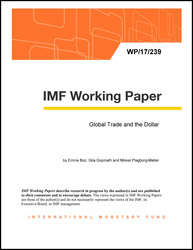
Global Trade and the Dollar
We document that the U.S. dollar exchange rate drives global trade prices and volumes. Using a
newly constructed data set of bilateral price and volume indices for more than 2,500 country
pairs, we establish the following facts: 1) The dollar exchange rate quantitatively dominates the
bilateral exchange rate in price pass-through and trade elasticity regressions. U.S. monetary
policy induced dollar fluctuations have high pass-through into bilateral import prices. 2) Bilateral
non-commodities terms of trade are essentially uncorrelated with bilateral exchange rates.
3) The strength of the U.S. dollar is a key predictor of rest-of-world aggregate trade volume and
consumer/producer price inflation. A 1 percent U.S. dollar appreciation against all other
currencies in the world predicts a 0.6–0.8 percent decline within a year in the volume of total
trade between countries in the rest of the world, controlling for the global business cycle. 4)
Using a novel Bayesian semiparametric hierarchical panel data model, we estimate that the
importing country’s share of imports invoiced in dollars explains 15 percent of the variance of
dollar pass-through/elasticity across country pairs. Our findings strongly support the dominant
currency paradigm as opposed to the traditional Mundell-Fleming pricing paradigms.
Publication date: November 2017
ISBN: 9781484327975
$18.00
Add to Cart by clicking price of the language and format you'd like to purchase
Available Languages and Formats
| English |
Prices in red indicate formats that are not yet available but are forthcoming.
Topics covered in this book
This title contains information about the following subjects.
Click on a subject if you would like to see other titles with the same subjects.
Bayesian semiparametrics , dominant currency , exchange rate passthrough , hierarchical Bayes , panel data , trade elasticity , US dollar , exchange rate pass-through , Bayesian Analysis , Models with Panel Data , Country and Industry Studies of Trade
Summary
Copyright © 2010 - 2024
Powered by:
AIDC



